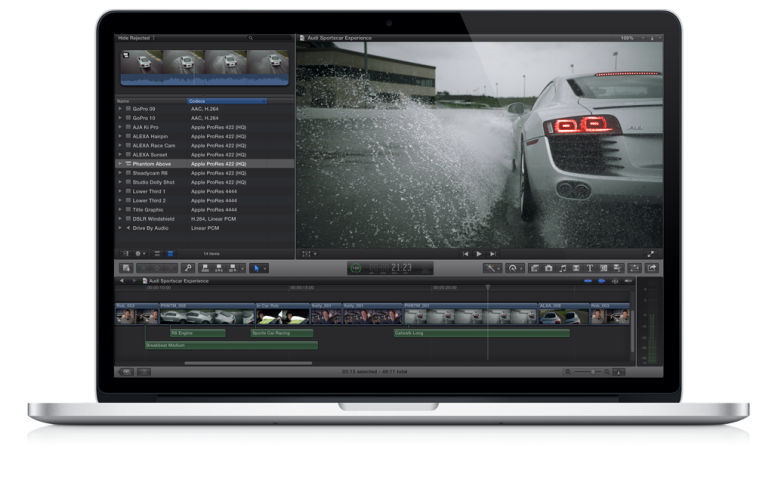Recently, Apple announced and showcased their new vision for 64-bit non-linear editors (NLEs). They called it Final Cut Pro X (FCPX). The news of this NLC sent waves through the industry, quickly appearing to be the biggest feature at NAB 2011. Finally, Apple released FCPX. Letting my inner child’s excitement take over, I went online and download it. Many technology review blogs haven’t yet explored this software deeply; I will show you the complete details and user experience of Apple’s Final Cut Pro X.
As the software loaded up, I noticed that the process was much faster than it was on previous versions. At first glance, the interface looked suspiciously like iMovie. As I let my eyes guide me through this new terrain for something familiar, and looked up at the toolbar options, I soon realized that a lot of options were missing. I hit some keyboard shortcuts to get my bearings, but with nearly every shortcut command, something entirely new presented itself.
I went through the sequence settings, and to my amazement, found very few options. For instance, FCPX runs solely on Apple ProRes! Mind you, ProRes is a great set of codecs to work on, and I myself use them quite frequently, especially for footage from DSLRs. However, they are highly compressed for commercial/film work, and to have all of my footage just natively converted to ProRes, without even an option, is a nightmare. Then I got the ultimate shock – FCPX wasn’t supporting my AJA Kona 3 I/O board! I did a quick Web search for the drivers, but unfortunately, found none. They had taken out I/O support from the software, temporarily leaving my expensive and very useful audio monitors, as well as my sanity monitor (broadcast monitor), as good as paper weights.
Another shocker was the lack of media control over my projects (or events, as they now call them). FCPX just seemed to pick everything up and throw it in the default directory. Not one to easily deterred, I imported my media and dropped two separate clips on the timeline, only for them to be snapped together. This was thanks to the dreaded magnetic timeline Apple was raving about at NAB. It’s a nightmare for any editor to not have an open timeline to make multiple optional cuts and have them spread out.
Backend rendering was the first relief after a series of disappointments. The 64-bit engine allows you to continue making your cut while the software does all preview and codec rendering in the background, making efficient use of the extra RAM that the 32-bit Final Cut Studio wasn’t able to tap into. The viewer really makes the footage look good when you preview it because it maximizes your GPU, but I still preferred having my I/O board do that for me on my sanity monitor. And these nifty features were nothing new after the prior release of Adobe’s 64-bit CS5 and CS5.5 Mercury Engine.
Another notable feature is effect playback in real-time. This means one can go through the effect presets and preview them without having to apple them onto the shot first. Apple has also integrated their popular color-grading and connection software “Color” into FCPX. Oh, and FCPX doesn’t run audio as default mono or stereo tracks, it reads it as 5.1. Who needs anything else when you have 5.1 to work with!
One of the crazy things Apple did with the original release of FCPX was that they didn’t allow it to be backward compatible with project files from previous versions. Surprisingly, they only allow people to import iMovie projects, which gave birth to the name iMovie Pro for FCPX! Subsequent updates allow users to import old FCP project files as well as EDLs (edit decisions list) files (XML) for proper workflows. However, with magnetic timeline always being a factor, and knowing what my timelines looked like, I decided not to even bother with updating.
Unfortunately, FCPX got a lot more wrong than it got right. Apple took everything that made FCPX a weapon of choice for me and most editors, and threw it out of the window. They have vowed to bring FCP back to being the industry standard NLE, but I don’t expect that to happen any time soon.
FCPX will definitely take some time before it can be the best again – if ever. Until then, Adobe and Avid have the window they needed to do the damage they’ve always wanted to do. Once a software package becomes an industry standard, it leads to dramatic innovations in its further development. All of this points to the possibility that Apple’s FCP may very well be left behind forever. For the future, I am waiting eagerly to explore the upcoming iPad 4 from Apple. For now, checkout the Apple iPad 4 release date, features and social media calls to know something about the upcoming giant from Apple!




